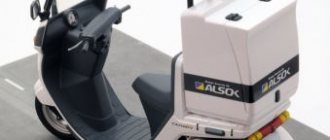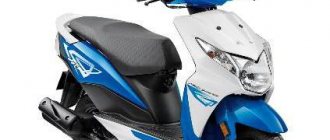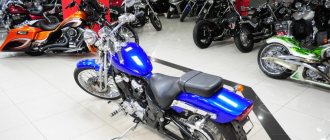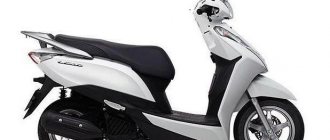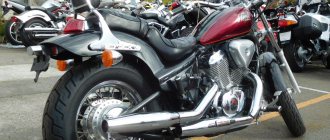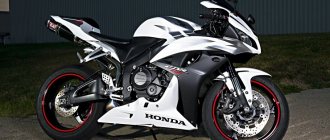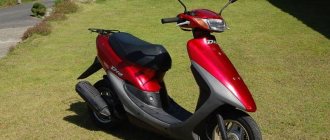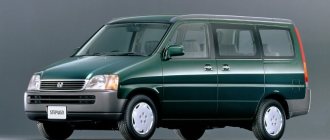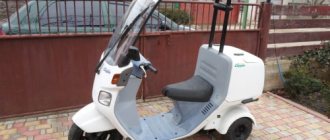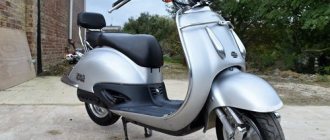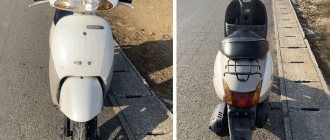Review and technical characteristics of the scooter
The Honda Today scooter is equipped with a single-cylinder four-stroke engine, which allows you to make daily trips around the city in comfort. The engine is quite powerful (4 hp at 8000 rpm), air-cooled and capable of reaching speeds of up to 60 km/h. The engine capacity is 49 cm3, which allows you not to register the vehicle with the traffic police and drive a scooter without a category A1 license. Both front and rear brakes are drum brakes. Today is available in pink, red and blue colors.
Honda Today - a scooter made in retro style
The Honda Today af61 has the following advantages:
- Stylish design. The '80s-inspired look will turn heads on the road. In addition, retro is now back in trend, which means that a scooter can become not only a means of transport, but also a fashion accessory.
- Aerodynamics. Decorative plastic gives the scooter the ability to better cut through air flow, which has a positive effect on fuel consumption.
- Ride comfort. In addition to the fact that the scooter owner does not have to constantly change gears, the soft suspension and characteristic landing provide maximum riding comfort.
Of course, a scooter accelerates slower than a moped due to the smaller wheel diameter, which should also be taken into account. In addition, small wheels spin faster, which can be dangerous for skidding on wet pavement.
Specifications
Reliable, safe Honda Today is equipped with a four-stroke, single-cylinder engine whose power reaches 3.8 horsepower. Maximum speed – 60 km/h. Thanks to a carefully thought-out steering system, drum brakes, and ergonomic shape, using the scooter is a pleasure. The ride is calm, the ride is soft, smooth, without sudden jerks. Main technical parameters of the model:
- engine capacity: 49 cm3;
- water cooling system;
- CVT transmission;
- fuel consumption – 1.6-2 l/100 km;
- gas tank capacity – 5 l;
- wheel size - 80/100-10;
- weight – 75 kg.
The Honda Today scooter is an ideal option for fast, comfortable, and most importantly safe movement around the city. The product is equipped with parts made of high-quality, wear-resistant materials, which ensures a long service life. Despite the retro style, the scooter looks fresh, because when developing the design of the model, the manufacturer refused to use chrome parts. The vehicle engine is environmentally friendly, high-performance, and economical. The scooter consumes 1.54 liters per 100 km, if the speed does not exceed 30 km/h.
Operation, maintenance and repair
Honda Today is a fairly repairable scooter. All that needs to be done to get to the main components is to remove the decorative plastic, but if the plate itself was damaged, the part will have to be completely replaced. Servicing a variator also costs a certain amount, and not everyone can repair it. By the way, Honda Today is absolutely not afraid of moisture, because all the main components are reliably protected from water by plastic.
In order for a scooter to serve for a long time and trouble-free, it is important not only to be able to repair it, but also to ride in such a way that repairs are required as rarely as possible. New equipment must be tested before everyday use. The running-in period of the Honda Today literally determines the future fate of the scooter, because it allows you to get used to the operating features of the engine and main components. During break-in, do not heavily load the scooter and ride with the throttle fully raised. These recommendations should be followed during the first 1000 km of driving, so as not to deteriorate the performance of the Honda Today in the future.
Replacing consumables
All modern scooters use two types of oil - motor and transmission. It is not recommended to use low quality oil. It is preferable to fill in synthetic rather than mineral oils. In order for all components to work correctly, it must be changed regularly - on average once every 3000 km, if a high-quality consumable is used. During the break-in period, the oil needs to be changed more often.
Honda Today is not afraid of water
Typically, the replacement frequency looks like this:
- After the first 300 km.
- After 1000 km.
- After 2000 km.
- Then the oil is changed every 2-4 thousand kilometers, as necessary.
Transmission oil can be changed less frequently, approximately every 4-6 km.
It is very important to pay attention to the air filter. The filter element needs to be replaced, but you can simply extend its life: wash it in gasoline and treat it with a special product. A poorly impregnated filter will not clean the air well. If you often drive on dusty dirt roads, you need to change the filter more often.
The variator belt and weights are also consumables. The belt wears out quite quickly, so do not forget to change it.
Every year before the start of the summer season, all cables and joints should be lubricated, and the fuel filter should be replaced with a new one.
It is important to pay special attention to the air filter on a scooter.
Ignition installation
Without an ignition system, it is impossible to move a vehicle with a gasoline or diesel engine, so the quality of operation of the scooter will depend on it. The correct selection of spark plugs and adjusted ignition will allow you to start the scooter even in cold weather.
Before setting the ignition, you need to make sure that fuel enters the engine without problems. If necessary, clean the carburetor.
First you need to find the optimal position of the timing star on the Honda Today. This is done simply - there is a letter “T” on the star, which should coincide with the protrusion on the crankcase. The procedure is performed either manually or using a kickstarter.
A faulty ignition can cause a four-stroke engine to fail, so it is very important to do everything correctly.
Features Honda Today
Description of the car Honda Today
The Honda Today hatchback was produced between 1990 and 1996. During this time, in 1993, the car was modernized, and as a result of the changes, the body design changed so significantly that the automaker could easily assign a different name to the vehicle.
This model was developed for those who need a car for everyday use in the city. Specialists from the Honda concern have given the car such qualities as high maneuverability, compact dimensions with a fairly spacious interior, and economical power units. In the second generation, the hatchback acquired a “positive” appearance, characterized by round headlight blocks and a non-standard arrangement of a number of body elements.
Exterior
The developers of the Honda concern gave the hatchback dimensions 3295x1395x1330 mm, curb weight Today - 1990 - 640 kilograms, tire size 145 / 70R12 69S. The car is raised above the road by 155 mm, the wheelbase is 2330 mm, and the turning circle is 9 meters. The body has a three-door layout, the hood is inclined at a 35-degree angle, and the compact headlight units are shaped like an elongated oval. The wide bumper has an air intake filled with horizontal and vertical slats that form a mesh with large cells. Rectangular strips of daytime running lights are installed under the headlight units. The wheel arches are visually united by a narrow strip of stamping, and the side lights are located on the rear bumper.
In the second generation, the overall dimensions of the car were preserved; the tire size changed to 155/70 SR12. The wings are given a teardrop shape, round headlight blocks are built into them, the features of the air intake layout remain unchanged. The body received a five-door layout, more streamlined outlines. Large brake light blocks are oriented vertically, door handles are hidden in the body.
Interior
The cabin of the Honda hatchback is trimmed with fabric; the interior space of Today-1990 is designed to accommodate four people. For rear passengers there are separate seats, tightly adjacent to each other. The front passenger seats provide minimal lateral and lumbar support; between the seats there is a handbrake lever and transmission selector. The rectangular instrument panel houses a large semicircle speedometer and several color indicators. The compact console is equipped with car audio controls and sliders for adjusting the intensity of the air conditioner.
In the second generation, the hatchback's interior design remained virtually unchanged, with the exception of the arrangement of equipment in the driver's seat. Here the instrument panel contains scales dulled into the body, next to them are the system keys and the car radio. A block with heater and ventilation controls is suspended under these elements.
Specifications
The line of power units of the Honda Today hatchback consists of two small-displacement gasoline engines. The base unit is a 42-horsepower unit with a peak thrust of 53 Nm, a volume of 656 cc. centimeters, fuel consumption AI-92 is 4.3 liters. The top unit develops a power of 52 hp. forces, its peak thrust is 55 Nm.
Honda New Dio AF-62/68 scooter review
The Dio scooter series is represented by the current latest line - Honda New Dio. All the best of developments are present in this 50 cc scooter. This is a four-stroke injection engine, durable and lightweight aluminum frame. The design of the model has changed slightly, in particular the shape of the front fairing, although the characteristic features of Dio are immediately visible.
The Honda Dio AF-62 with the AF61E engine was born in 2003 and was produced until 2007. This year it underwent restyling, received an updated frame and injection instead of the usual carburetor. The new engine received the index AF67E.
Specifications
Engine: Engine type – AF61E/AF67E, displacement 49 cc. see Number of cylinders – 1. Number of strokes – 4. Cooling system – liquid cooling. Maximum engine power – 3.8/4.1 hp. at 8250 rpm. Torque – 0.38 kg*m / 7500 rpm. Compression ratio – 10.1. Transmission – variator. Ignition - dynastarter. The tire size of the front and rear wheels is 80/100-10. Oil tank volume – 0.68 l. Gas tank volume – 4.6 liters. Maximum speed – 60 km/h. Chassis: Front wheel suspension type – telescopic. The rear wheel suspension type is pendulum. The front wheel brake type is drum. The rear wheel brake type is drum. Size and weight: Base – 1180 mm. Length – 1720 mm. Seat height – 695 mm. Ground clearance – 110 mm. Total weight – 73 kg.
Features and Benefits
The New Dio line began production in 2003, and this scooter is still in production. Currently, the AF-68 model is produced, which has an engine with injection (injector) and a four-stroke AF67E engine producing 4.1 hp, in contrast to the original AF-62 version with an AF61E engine producing 3.8 hp.
The main feature of the scooter is its extreme efficiency. Fuel consumption at cruising speed (30 km/h) is only 1.25 liters per 100 km. This is a record figure for scooters with this engine capacity.
The model is available in two trim levels: the standard Dio version with a front drum brake and the Dio Cesta with a front basket. Interestingly, the gas tank has finally moved from the underground space to the underseat, like most motorcycle models.
The Honda New Dio series is not as popular as all the previous ones. The reason for this is the novelty of the model, because it is still quite expensive, and spare parts are very difficult to find due to the small distribution of this line. And a four-stroke engine, no matter how economical it is, is inferior to a two-stroke engine in dynamics.
But that's not the main thing. The main thing is that while this model is being produced, we can say that Dio lives and will live.
Please note: This article and the images in it are subject to copyright. Partial or complete reproduction on other resources without permission is prohibited.
Characteristics of Honda Today / Honda Today
In September 1985, Honda added the Today mini 3-door hatchback to the mini class. The wheelbase of the car was 2330 mm. Until February 1988, a 2-cylinder OHC power unit with a displacement of 545 cm³ was installed under the hood, after which it was replaced by a 3-cylinder engine with a displacement of 547 cm³.
In 1990, due to changes in Japanese standards for small cars, Today had to go through some changes. The car began to be equipped with an in-line 3-cylinder SOHC engine with a volume of 656 cm³. The front part of the body has changed significantly. Instead of two round headlights, the car acquired square optics and lost the radiator grille. The external dimensions have increased slightly. With the new bumpers, the length of Today was 3295 mm. The internal equipment has been updated and the interior has been improved. An all-wheel drive modification was also produced (4WD FULLTIME with a viscous clutch).
In January 1993, the second generation came out. Technically, it was a modernization of the first generation, dressed in a new elegant body. The Honda Today was no longer available as a hatchback. The car received a unique body - a 3-door sedan. At first glance, it seems to be one-volume, but upon closer inspection, you can see the trunk disguised by a rack and a spoiler. The trunk opened like the side of a pickup truck. The glass remains in place, and the “secret door” is held horizontally by cables. By the way, the trunk volume was 120-130 liters. If necessary, it was possible to fold the back of the rear seat, thereby increasing the useful space five times.
The front part of the body is crowned with attractive round headlights. The interior design contains soft, pleasant colors. It is noteworthy that the interior is asymmetrical: the driver's seat is slightly larger than the front passenger seat. Potential buyers of Today were mainly young girls. The car was distinguished by its efficiency and good driving characteristics.
In May 1993, a four-door version appeared, called Today Associe.
The line of power units offered two engines: a standard 3-cylinder with a volume of 657 cm³ and its top version with MTREC technology borrowed from the Honda Beat. Both engines were equipped with a choice of a five-speed manual transmission or a three-speed automatic.
In 1996, Honda carried out a facelift of the model. The unique 3-door sedan body style, with a pickup truck-like tailgate, was replaced with a conventional hatchback, which entailed significant design changes in the rear of the car.
Honda Today was discontinued in 1998.
